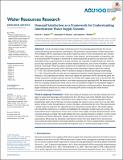Notice
This is not the latest version of this item. The latest version can be found at:https://dspace.mit.edu/handle/1721.1/132243.2
Demand Satisfaction as a Framework for Understanding Intermittent Water Supply Systems
| dc.date.accessioned | 2021-09-20T18:21:27Z | |
| dc.date.available | 2021-09-20T18:21:27Z | |
| dc.identifier.uri | https://hdl.handle.net/1721.1/132243 | |
| dc.description.abstract | ©2019. The Authors. Nearly one billion people worldwide receive water through piped networks that are not continually pressurized and operate intermittently. The prevalence and persistence of these Intermittent Water Supplies (IWS) is surprising as this mode of operation induces water contamination and customer equity issues. Shortages of source water, customers' water demand, and leaking pipes are frequently cited as necessitating IWS. We propose a framework for understanding the persistence and operation of IWS. The supply system is represented by an average customer and a spatially averaged leakage rate. With this macroscopic hydraulic model, we relate customer demand satisfaction, source water availability, customer demand, and leakage. While this approach ignores the complexities of network topology, we find that the model approximates real systems well (calibrating to four intermittent reference networks achieved R2>0.87). The calibrated model is robust to moderate changes in demand and leakage (maintaining R2>0.81). Using the model, we show that the tipping point between satisfied demand and unsatisfied demand is a local optimum for utilities, which may explain the persistence of IWS. Beyond this point, the volume received by customers does not increase, but utilities must supply more water to the network. The generality of the proposed model enables its use when regulating and upgrading IWS. We demonstrate the latter by critiquing a performance-based contract that was intended to improve an intermittent supply in India. Demand satisfaction has profound implications for hydraulics and human welfare. We propose the degree of demand satisfaction as a metric for evaluating IWS and for tracking the United Nations Sustainable Development Goal 6.1. | en_US |
| dc.language.iso | en | |
| dc.publisher | American Geophysical Union (AGU) | en_US |
| dc.relation.isversionof | 10.1029/2018WR024124 | en_US |
| dc.rights | Creative Commons Attribution-NonCommercial-NoDerivs License | en_US |
| dc.rights.uri | http://creativecommons.org/licenses/by-nc-nd/4.0/ | en_US |
| dc.source | American Geophysical Union (AGU) | en_US |
| dc.title | Demand Satisfaction as a Framework for Understanding Intermittent Water Supply Systems | en_US |
| dc.type | Article | en_US |
| dc.relation.journal | Water Resources Research | en_US |
| dc.eprint.version | Final published version | en_US |
| dc.type.uri | http://purl.org/eprint/type/JournalArticle | en_US |
| eprint.status | http://purl.org/eprint/status/PeerReviewed | en_US |
| dc.date.updated | 2020-06-03T16:14:40Z | |
| dspace.date.submission | 2020-06-03T16:14:43Z | |
| mit.journal.volume | 55 | en_US |
| mit.journal.issue | 7 | en_US |
| mit.license | PUBLISHER_CC | |
| mit.metadata.status | Authority Work and Publication Information Needed |
